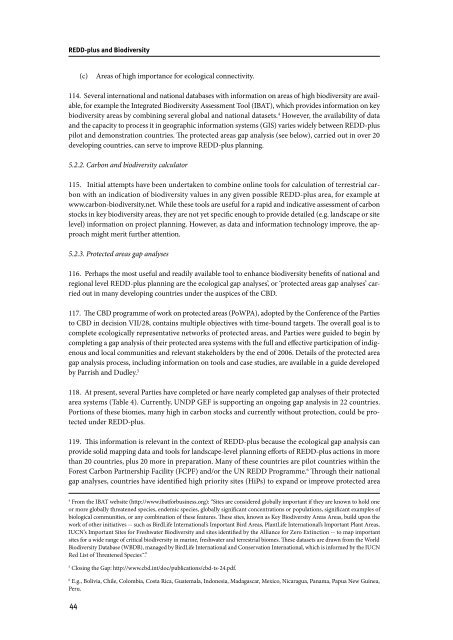REDD-plus and Biodiversity - Convention on Biological Diversity
REDD-plus and Biodiversity - Convention on Biological Diversity
REDD-plus and Biodiversity - Convention on Biological Diversity
Create successful ePaper yourself
Turn your PDF publications into a flip-book with our unique Google optimized e-Paper software.
<str<strong>on</strong>g>REDD</str<strong>on</strong>g>-<str<strong>on</strong>g>plus</str<strong>on</strong>g> <str<strong>on</strong>g>and</str<strong>on</strong>g> <str<strong>on</strong>g>Biodiversity</str<strong>on</strong>g><br />
(c)<br />
Areas of high importance for ecological c<strong>on</strong>nectivity.<br />
114. Several internati<strong>on</strong>al <str<strong>on</strong>g>and</str<strong>on</strong>g> nati<strong>on</strong>al databases with informati<strong>on</strong> <strong>on</strong> areas of high biodiversity are available,<br />
for example the Integrated <str<strong>on</strong>g>Biodiversity</str<strong>on</strong>g> Assessment Tool (IBAT), which provides informati<strong>on</strong> <strong>on</strong> key<br />
biodiversity areas by combining several global <str<strong>on</strong>g>and</str<strong>on</strong>g> nati<strong>on</strong>al datasets. 4 However, the availability of data<br />
<str<strong>on</strong>g>and</str<strong>on</strong>g> the capacity to process it in geographic informati<strong>on</strong> systems (GIS) varies widely between <str<strong>on</strong>g>REDD</str<strong>on</strong>g>-<str<strong>on</strong>g>plus</str<strong>on</strong>g><br />
pilot <str<strong>on</strong>g>and</str<strong>on</strong>g> dem<strong>on</strong>strati<strong>on</strong> countries. The protected areas gap analysis (see below), carried out in over 20<br />
developing countries, can serve to improve <str<strong>on</strong>g>REDD</str<strong>on</strong>g>-<str<strong>on</strong>g>plus</str<strong>on</strong>g> planning.<br />
5.2.2. Carb<strong>on</strong> <str<strong>on</strong>g>and</str<strong>on</strong>g> biodiversity calculator<br />
115. Initial attempts have been undertaken to combine <strong>on</strong>line tools for calculati<strong>on</strong> of terrestrial carb<strong>on</strong><br />
with an indicati<strong>on</strong> of biodiversity values in any given possible <str<strong>on</strong>g>REDD</str<strong>on</strong>g>-<str<strong>on</strong>g>plus</str<strong>on</strong>g> area, for example at<br />
www.carb<strong>on</strong>-biodiversity.net. While these tools are useful for a rapid <str<strong>on</strong>g>and</str<strong>on</strong>g> indicative assessment of carb<strong>on</strong><br />
stocks in key biodiversity areas, they are not yet specific enough to provide detailed (e.g. l<str<strong>on</strong>g>and</str<strong>on</strong>g>scape or site<br />
level) informati<strong>on</strong> <strong>on</strong> project planning. However, as data <str<strong>on</strong>g>and</str<strong>on</strong>g> informati<strong>on</strong> technology improve, the approach<br />
might merit further attenti<strong>on</strong>.<br />
5.2.3. Protected areas gap analyses<br />
116. Perhaps the most useful <str<strong>on</strong>g>and</str<strong>on</strong>g> readily available tool to enhance biodiversity benefits of nati<strong>on</strong>al <str<strong>on</strong>g>and</str<strong>on</strong>g><br />
regi<strong>on</strong>al level <str<strong>on</strong>g>REDD</str<strong>on</strong>g>-<str<strong>on</strong>g>plus</str<strong>on</strong>g> planning are the ecological gap analyses’, or ‘protected areas gap analyses’ carried<br />
out in many developing countries under the auspices of the CBD.<br />
117. The CBD programme of work <strong>on</strong> protected areas (PoWPA), adopted by the C<strong>on</strong>ference of the Parties<br />
to CBD in decisi<strong>on</strong> VII/28, c<strong>on</strong>tains multiple objectives with time-bound targets. The overall goal is to<br />
complete ecologically representative networks of protected areas, <str<strong>on</strong>g>and</str<strong>on</strong>g> Parties were guided to begin by<br />
completing a gap analysis of their protected area systems with the full <str<strong>on</strong>g>and</str<strong>on</strong>g> effective participati<strong>on</strong> of indigenous<br />
<str<strong>on</strong>g>and</str<strong>on</strong>g> local communities <str<strong>on</strong>g>and</str<strong>on</strong>g> relevant stakeholders by the end of 2006. Details of the protected area<br />
gap analysis process, including informati<strong>on</strong> <strong>on</strong> tools <str<strong>on</strong>g>and</str<strong>on</strong>g> case studies, are available in a guide developed<br />
by Parrish <str<strong>on</strong>g>and</str<strong>on</strong>g> Dudley. 5<br />
118. At present, several Parties have completed or have nearly completed gap analyses of their protected<br />
area systems (Table 4). Currently, UNDP GEF is supporting an <strong>on</strong>going gap analysis in 22 countries.<br />
Porti<strong>on</strong>s of these biomes, many high in carb<strong>on</strong> stocks <str<strong>on</strong>g>and</str<strong>on</strong>g> currently without protecti<strong>on</strong>, could be protected<br />
under <str<strong>on</strong>g>REDD</str<strong>on</strong>g>-<str<strong>on</strong>g>plus</str<strong>on</strong>g>.<br />
119. This informati<strong>on</strong> is relevant in the c<strong>on</strong>text of <str<strong>on</strong>g>REDD</str<strong>on</strong>g>-<str<strong>on</strong>g>plus</str<strong>on</strong>g> because the ecological gap analysis can<br />
provide solid mapping data <str<strong>on</strong>g>and</str<strong>on</strong>g> tools for l<str<strong>on</strong>g>and</str<strong>on</strong>g>scape-level planning efforts of <str<strong>on</strong>g>REDD</str<strong>on</strong>g>-<str<strong>on</strong>g>plus</str<strong>on</strong>g> acti<strong>on</strong>s in more<br />
than 20 countries, <str<strong>on</strong>g>plus</str<strong>on</strong>g> 20 more in preparati<strong>on</strong>. Many of these countries are pilot countries within the<br />
Forest Carb<strong>on</strong> Partnership Facility (FCPF) <str<strong>on</strong>g>and</str<strong>on</strong>g>/or the UN <str<strong>on</strong>g>REDD</str<strong>on</strong>g> Programme. 6 Through their nati<strong>on</strong>al<br />
gap analyses, countries have identified high priority sites (HiPs) to exp<str<strong>on</strong>g>and</str<strong>on</strong>g> or improve protected area<br />
4<br />
From the IBAT website (http://www.ibatforbusiness.org): “Sites are c<strong>on</strong>sidered globally important if they are known to hold <strong>on</strong>e<br />
or more globally threatened species, endemic species, globally significant c<strong>on</strong>centrati<strong>on</strong>s or populati<strong>on</strong>s, significant examples of<br />
biological communities, or any combinati<strong>on</strong> of these features. These sites, known as Key <str<strong>on</strong>g>Biodiversity</str<strong>on</strong>g> Areas Areas, build up<strong>on</strong> the<br />
work of other initiatives -- such as BirdLife Internati<strong>on</strong>al’s Important Bird Areas, PlantLife Internati<strong>on</strong>al’s Important Plant Areas,<br />
IUCN’s Important Sites for Freshwater <str<strong>on</strong>g>Biodiversity</str<strong>on</strong>g> <str<strong>on</strong>g>and</str<strong>on</strong>g> sites identified by the Alliance for Zero Extincti<strong>on</strong> -- to map important<br />
sites for a wide range of critical biodiversity in marine, freshwater <str<strong>on</strong>g>and</str<strong>on</strong>g> terrestrial biomes. These datasets are drawn from the World<br />
<str<strong>on</strong>g>Biodiversity</str<strong>on</strong>g> Database (WBDB), managed by BirdLife Internati<strong>on</strong>al <str<strong>on</strong>g>and</str<strong>on</strong>g> C<strong>on</strong>servati<strong>on</strong> Internati<strong>on</strong>al, which is informed by the IUCN<br />
Red List of Threatened Species.”<br />
5<br />
Closing the Gap: http://www.cbd.int/doc/publicati<strong>on</strong>s/cbd-ts-24.pdf.<br />
6<br />
E.g., Bolivia, Chile, Colombia, Costa Rica, Guatemala, Ind<strong>on</strong>esia, Madagascar, Mexico, Nicaragua, Panama, Papua New Guinea,<br />
Peru.<br />
44

















